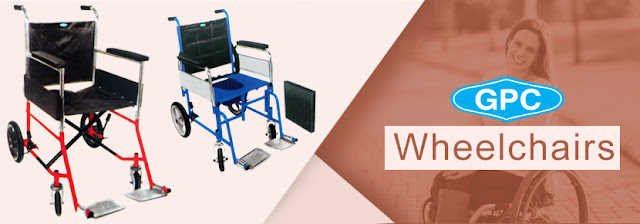A wheelchair is a supportive aid to mobilize a patient who
is unable to move without support. It is an essential requirement in any hospital,
laboratory, an airport, a railway station in fact every public place should be
invariably equipped with a wheelchair. Individuals, who are ill and need
support for moving, need it for personal use, in their homes as well.
Therefore, it is very important to have a complete guide about how to choose
the appropriate wheel chair as per the need of the patient.
Wheelchairs are of different types depending upon the weight,
size, age and condition of the patient. However, primarily there are three
types of wheel chair according to the need of the patient.
- Wheelchair that is self propelled i.e. the patient himself or herself controls the movement of the wheelchair
- Wheelchair that is steered by an attendant
- Wheelchair that is electrically powered and is used for pavements and for road use.
Points to Ponder While Choosing a Wheel Chair
- Whether the wheel chair is required for short term use or is permanently required
- Whether the wheel chair is to be used by the patient himself or herself or is going to be used with the assistance of an attendant
- Whether the need of the wheel chair is for outdoor use or indoor use
- Whether the wheel chair needs to be carried in and out of the car boot
- Whether the wheel chair is for a disabled person, a child , or an old age person
- The weight and size of the body frame of the person for whom the wheel chair is needed
Once, you have the above points in mind, you can choose from
the different types of wheel chairs available in the market.
Different Types of Wheel Chairs
- Standard Wheelchair - A Standard wheel chair has a seat width of 18” and a depth of 16”
- Narrow Wheelchair - Narrow wheel chair have a width less than 18’’ and are meant for people with thin body frame
- Wide Wheelchair - Many wheel chairs have a width with seats width up to 24” meant for people with large body frames
- Reclining Wheelchair - A reclining wheel chair gives the patient the options to convert it into reclining comfort position
- Transport Wheelchair - These wheel chairs cannot be self propelled and need the assistance of an attendant for its use
- Heavy Duty Wheelchair - This type of wheel chair is required for people who exceed the normal weight limit of standard wheel chairs
- Pediatric Wheelchair - Children and people with small body frames and light weight require this type of wheel chair
- Hemi Wheelchair - Hemi Wheel Chairs have a lower seat to floor height than standard wheel chairs
Tips that Will Help You Choose the Right Wheel Chair
- If you are going for a manual wheel chair there is either a standard or an active- user type wheel chair
- A standard wheel chair cannot be modified whereas an active-user wheel chair can be adapted and adjusted according to the requirement of the patient
- Larger rear wheels make the wheelchair easier to maneuver
- Lightweight wheel chairs that can be folded and adjusted and put in the rear seat of the car are good for patients who travel outdoors
- Look out for wheels positioned further forward on an adjustable axle which makes the wheel chair easier to move and with less efforts
- The position of the foot, the arm rest and the size of the chair should all be well evaluated before choosing the right wheel chair
- It is very important to read the instructions given with the wheel chair to be cautious about the safety of the patient
- For disabled people the wheel chair should be purchased as per the condition of the patient
- The weight of the wheel chair and the flexibility of it should also be kept in mind while purchasing it
- Before finalizing the specific type of wheel chair, make sure that you take it around the house or road to see whether this is the right wheel chair required for your patient
When buying the wheel chair you should be aware of the best
price available with the required features of the wheel chair. We recommend GPC Medical wheel chairs that are not only tested and tried by a large number of
patients, hospitals, and community centers but also give you good after sales
service and the best price.





